
The Pirate Surgeon's Quarters: 1 2 3 4 5 6 7 8 9 10 11 12 Next>>
The Pirate Surgeon's Quarters in the Golden Age of Piracy, Page 9
Conditions of the Surgeon's Working Area
"…you are to get [your chests], with your self and Crew, on Board; and see them placed in a dry Place, and as convenient to be come at as possible. And let your Surgery Chest be fast lashed that it may not over set in bad Weather by the rowling of the Ship."(John Moyle, The Sea Chirurgeon, p. 45)
Moyle made putting the surgical supplies aboard and setting up sound nice and neat - just find a place on the ship where it's dry and secure everything. Other accounts and commentaries flesh this out, suggesting there was a
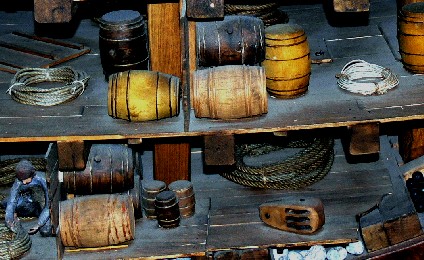
Photographer: Wolfgang Sauber
Cutaway Model Showing the Lower Decks of the 1627 Swedish Ship Vasa
little more to the surgeon's operating environment on the orlop deck.
Modern author Stephen Bown gives a bit more of a vivid account in his book:
The surgeon's mate dwelled within the bowels of the ship, in a six-foot-square canvas enclosure in the cockpit on the orlop deck, directly above the hold in the front of the vessel, where the rocking was greatest, the air foulest, and the natural light faintest. It was barely large enough to contain a sea chest, and a medical chest and the canvas walls pinned to the overhead beams provided scant privacy from the general crew.1
Bown brings up several facets of the operating theater that bear closer scrutiny. Let's look at his comment in view of period and near-period literature. We have already discussed the use of the canvas enclosure and why pirates would probably not have them set up for the surgeon.
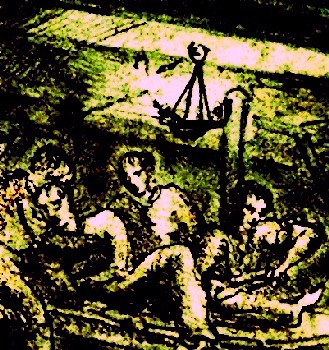
Lighting in the Cockpit, unknown artist (1820)
Lighting would be a significant challenge for a ship's surgeon dwelling in the bowels of ship during delicate operations. Being at or below the waterline meant there would be no openings in the side of the ship to let in ambient light. While discussing the pros and cons of tying off bleeding arteries with ligatures (thin pieces of cloth), sea surgeon James Handley dryly commented that "where you must operate by Candle-light, a Ligature of the Vessels is not so practicable"2.
John Moyle ordered the surgeon to " place good store of Lights about the Platform, in Lanthorns", the lanterns presumably to keep the wax from dripping on the patients as well as keep flailing patients from being burned. He also recommended putting "two of the largest (with-out Lanthorns) in the place where you are to operate."3 While unguarded candles may present a greater risk of burning, Moyle knew it was important to have the most light possible here.
Sea surgeon John Atkins suggested placing "some large Lights, in Sticking-Iron Candlesticks, as taking least Room, and undisturbed by the Motions of the Ship; three or four moving ones also, and Snuffers"4, the candle snuffers highlighting the importance of safety. 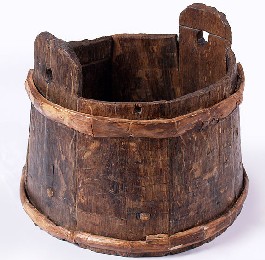
Photographer: Peter Crossman
Wooden Bucket Recovered from Mary Rose,
A mid-16th Century Carrack Vessel
Atkins' comment above also notes that candlesticks will be less disturbed 'by the Motions of the Ship.' A ship at sea almost constantly rocks - the larger the waves, the more the ships moves. During a storm the movement can be particularly violent. Seaman Edward Barlow noted that "in stormy weather... the ship rolled and tumbled as though some great millstone were rolling up one hill and down another"5. This would make precision emergency surgery challenging at best.
The quality of the air that Bown mentioned may seem like a curious issue, but it must be remembered that the men often had their sleeping quarters on the orlop deck and bathing was not quite as prevalent as it is today. If the ship had a sick bay, it would also be located there. While we can't say with certainty that pirates were more lax about cleaning their ship than naval seamen, it does not seem like a stretch to suggest this.
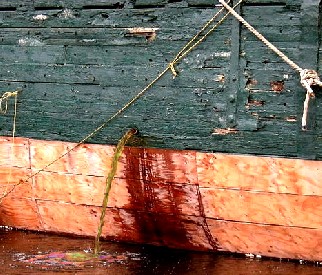
Photographer: Joe Mabel
Bilge Water Being Pumped From the Hold
In addition, the hold was directly below the surgeon's enclosed operating quarters. Any water inside the ship would make it's way to the hold and collect. Writing in 1727 of his adventures at sea, Captain Alexander Hamilton described the shore in Gambroon (modern Iran), noting that the water stank badly and "tarnishes Gold and Silver, as bad as the bilge Water [in the hold] of a tight Ship."6
Speaking of water, although Bown does not mention it specifically, a ship was a very damp place to be. As waves washed over her deck, the water would make its way downward, going in open hatches and between deck boards in ships that were not well sealed.
While regular maintenance of wooden vessels called for caulking them with cotton and oakum (hemp fiber soaked in pine tar), she may still not stay dry as Hamilton suggests.
Storms made it particularly difficult to keep the inside of a ship dry.
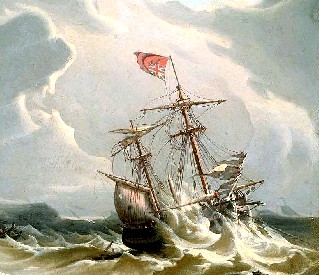
Artist: Robert Salmon
A Ship in a Storm (1828)
John Covel talks about this in his diary:
"We had most dismal turbulent weather for thre[e] whole dayes and nights, and a constant rain, with most dreadful thunder and Lightning almost all the time. The dry weather which we had till now had so parch'd the wast [waist - middle] of the ship and the upper timburs, and made all above so leaking, as I could not keep my cabin dry; one night I was soundly wet as I lay on my bed."7
Sailor Edward Barlow even coined a special term for the particularly stormy weather he encountered, revealing that there were "showers of rain so hard that it will wet a man 'dunge wet' before he can go the length of the ship."8 As a result, the environment on the orlop deck would be a damp and (during hot weather) humid place to work.
The last thing Bown mentions are the quarters, which we have already noted would be very cramped. The surgeon had several chests of tools and medicines required for his work. Depending on the design of the vessel, he might share the orlop deck with the cables in the cable-tier, the alternate controls for the ship, the sailor's belongings, cargo, cannons, the rowing equipment when the ship had sweeps and even the seamen's dining tables. When not in use on a small ship (such as the pirates would have used), the surgical equipment would have to be stowed out of the way as Moyle suggested.
On top of everything else, the orlop deck could be particularly noisy especially during a storm.

Artist: Jan Jozef
A Doctor's Surgery (circa 18th Century)
Tobias Smollet's character Roderick Random "was wakened by a most horrible din, occasioned by the play of the gun carriages upon the deck above, the cracking of cabins, the howling of the wind through the shrouds,
the confused noise of the ship's crew, the pipes of the boatswain
and his mates, the trumpets of the lieutenants, and the clanking of the chain pumps. ... I went above; but, if my sense of hearing was startled before, how must my sight have been appalled in beholding the effects of the storm!"9
I should note that representing every ship's orlop deck exclusively in these terms would be most unfair. A lot depended on the surgeon and his desire to keep his operating area clean and orderly. This was probably doubly true on a pirate or merchant ship. Even so, the cockpit and its close neighbor the cable tier would have been pretty challenging places for a ship's surgeon to work on a naval ship, let alone a pirate vessel.
1 Stephen R. Bown, Scurvy: How a Surgeon, a Mariner, and a Gentleman Solved the Greatest Medieval Mystery of the Age of Sail, p. 88; 2 James Handley, Colloquia Chirurgica: or The Art of Surgery, p. 142; 3 John Moyle, The Sea Chirurgeon, p. 49; 4 John Atkins, The Navy Surgeon, p. 148; 5 Edward Barlow, Barlow's Journal of his Life at Sea in King's Ships, East and West Indiamen & Other Merchantman From 1659 to 1703, p. 59; 6 Alexander Hamilton, British sea-captain Alexander Hamilton's A new account of the East Indies, 17th-18th century; 7 John Covel, "Extracts from the Diaries of Dr. John Covel, 1670-1679," Early Voyages and Travels in the Levant, edited by J. Theodore Bent, p. 126; 8 Barlow, p. 60;9 Tobias Smollett, The Adventures of Roderick Random, p. 183
Daily Sick and Ill Treatment
While battle is often the first thing that comes to mind
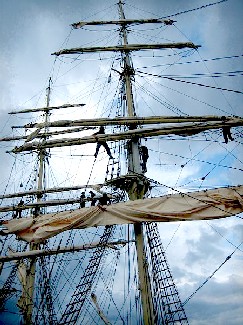
Photo: Pöllö
Men in the Sails of the Tre Kronerr (2008)
when considering the surgeon's duties, it was probably the part of his job he spent the least time performing; battles were relatively infrequent. Even pirates, as a general rule, preferred to rely on their reputations to convince their prey to strike their colors and surrender if they could avoid a fight. So the majority of a surgeon's work involved the day-to-day health problems that sailors encountered. There were plenty of such problems.
Many challenges faced a sailor while he went about his daily duty. There were the hazards of falling from the rigging onto the deck or down the steep ladders resulting in bruises and fractures. Fingers could be pinched in pulleys and under cannon and cargo, skin could be burned while running rope through it and opportunities for cuts and minor contusions abounded. There were problems associated with diet including upset stomachs, diarrhea, and decaying teeth. Fevers and illnesses could quickly sweep through the closed community aboard a ship following landfall. Visiting shore also increased the likelihood of contracting venereal diseases that must be dealt with. Accidents from drunkenness or minor skirmishes amongst the men could occur. However, surgical historian Elizabeth Bennion suggests that "the most common condition on board ship was hernia and other forms of rupture. The enormous physical strain of lifting and hauling, working the windlass, etc. combined with chronic constipation due to the diet, made hernia an occupational hazard for the seaman."1

Edward Low's Pirates Drinking, from Histoire
der
Engelsche zee-roovers
by Captain
Charles Johnson (1725)
In sum, there was much that the surgeon might be required to deal with during any long voyage, such as those to and from the Caribbean.
Pirate ships would be particularly susceptible to problems associated with their vices - those of drunkenness and indiscreet behavior while on land. Captain Johnson mentions in the most off-hand way in his seminal book on the pirates that even Edward Low's surgeon was "tollerably drunk, as it was customary for every Body to be"2.
Such vices were likely to result in accidents and a need for medical attention. This suggests that pirates would have particular recourse to the medical man on board. When attempting to prosecute one pirate surgeon, the Solicitor General noted that "the Doctor being ador'd among 'em as the pirates God for in him they chiefly confide for their cure and life, and in this trust and dependence it is".3 In 1718, Blackbeard even held the port of Charlestown for ransom in order to obtain a "Chest of Medicines"4 hinting at the great need that pirates had for medical attention.
Sea surgeon John Moyle advised young surgeons that "such as by reason of illness cannot come thither you must go to them where Lye."5 The surgeon or his mates tended those who were confined to their beds at least twice a day. Tobias Smollett's surgeon's mate character Roderick Random reported that it was his duty to tend the sick, the first daily session being after "rising [at 8am], and breakfasting with
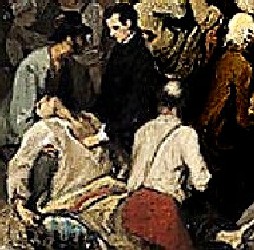
Artist: Alfred Johannot
Visiting the Sick, Detail from The Duke of
Orleans Visiting the Sick at l'Hotel Dieu (1832)
my comrades on biscuit and brandy" when "the sick were visited and assisted."6 The other session he reports was at "seven o'clock in the evening." Upon his arrival on a naval vessel, Random explains that he went with the ship's surgeon "Morgan [who] visited the sick, and having ordered what was proper for each, I [then] assisted [surgeon's mate] Thomson in making up his prescription"7.
Sea surgeon John Woodall, while a bit more loose in his prescription for visiting times, explained that the "Surgions Mate ought also daily to visite the Cabines of men, to see who hath any sicknesse or Imperfection."8 Even pirates were given time to recover when they were ill; in the account of Bartholomew Roberts' crew, it is noted in the court records that pirate James Skyrme "had really for several Months past been sick, and disqualified for any Duty", as part of the plea to prove that he was too ill to be firing upon the British ship that captured the crew. (Skyrme lost his case because the loss of his leg during the engagement with the British showed he was "more alert on such Occasions, than he was now willing to be thought"9.)
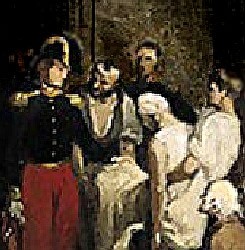
Artist: Alfred Johannot
Examining the Sick, Detail from The Duke of
Orleans Visiting the Sick at l'Hotel Dieu (1832)
Of course, like the would-be truant school boy, a man couldn't just claim to be sick in order to avoid work and be allowed to lie around in bed. He had to prove his case. "Anyone who was sick or injured presented himself to the surgeon and captain, justified and explained his injuries, and asked to be excused from his regular duties. The captain…attended the muster to discourage sailors from faking illness and shirking duty"10.
You can be sure that this was true whether the captain was naval, merchant or pirate. Each required a full complement of men; the naval captain because he had to have an adequate number of soldiers should they be needed for an attack, the merchant because he was usually lightly manned and the pirate because he needed to be able to put on a good show of force when trying to convince his prey to surrender without a fight, or to join the fray if such were required to take the prey ship.
Those requiring treatment of health issues which did not require them to be relieved of duty were to meet with the surgeon or his mates or assistants at a scheduled time to be treated. Moyle explains to young surgeons that the dressing "Box as well as your pocket Instruments must be carried every Morning to the Mast between Decks, where our Mortar [presumably brass] is usually rung, that such as have any Sore or Ailment may hear in any part of the Ship, and come thither to be drest."11
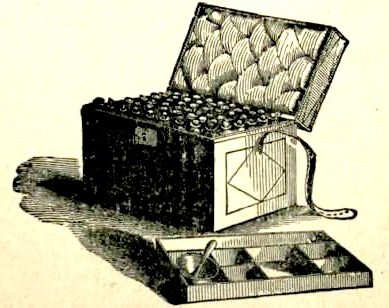
A Medicine Chest with a Plaster Box in the Foreground
Smollett tells it a little differently, explaining
At a certain hour in the morning, the boy of the mess went round all the decks, ringing a small hand-bell, and, in rhymes composed for the occasion, invited all those who had sores to repair before the mast, where one of the doctor's mates attended, with applications to dress them.12
Of course, before going to the mast, the surgeon or his mates had to prepare everything that they might need for treatments. Moyle details the preparation of the plaster box, ordering the surgeon to "see that your dressing box is furnished. That is a box with 6 or 8 Partitions in it, and a Place for Plaisters ready spread. In the Partitions you put your Pots and Glasses of Balsams and Oyles for present use."13
John Woodall gives a little more detail to the needed preparations when he explained to the surgeon's mate what was required to be in his plaster box. He was "to have ready against occasion Lint made, Plasters spread, Splints armed, Needles prepared, for stitching wounds, Rowlers [roller bandages] and Boulsters [bolsters], Dorssels [dossils], Tents, Buttons, Cappes [caps for amputation], Plegents [Pledgets], Tape, rowling Needles, and Thred prepared, and each other needful thing for his calling readie in their convenient places, placed against occasion be."14 Woodall was certainly ready for any contingency!
1 Elizabeth Bennion, Antique Medical Instruments, p. 155; 2 Captain Charles Johnson, A General History of the Pirates, 3rd Ed., p. 374; 3Johnson,p. 74; 4 George Francis Dow and John Henry Edmonds, Pirates of the New England Coast, p. 303; 5 John Moyle, The Sea Chirurgeon, p. 46; 6 Tobias Smollett, The Adventures of Roderick Random, p. 184;7 Smollett, p. 170; 8 John Woodall, the surgions mate, p. 2; 9 Johnson, p. 305; 10 Stephen Bown, Scurvy: How a Surgeon, a Mariner, and a Gentleman Solved the Greatest Medieval Mystery of the Age of Sail, p. 90; 11 Moyle, p. 45-6; 12 Smollett, p. 174; 13 Moyle, p. 45; 14 Woodall, ibid.

